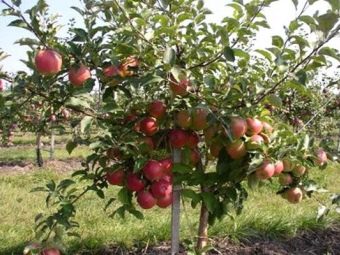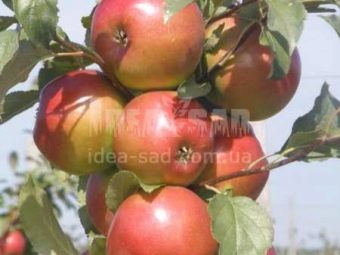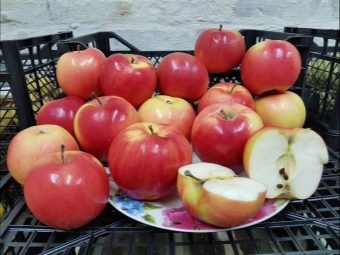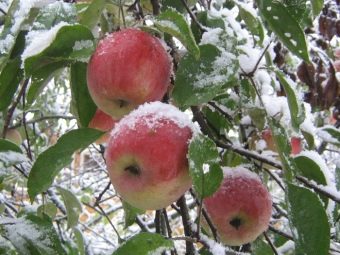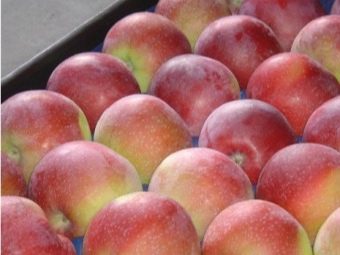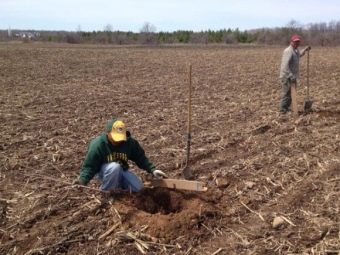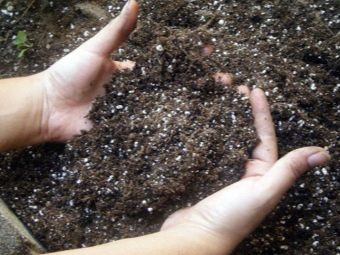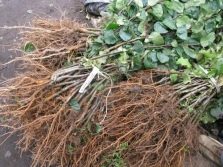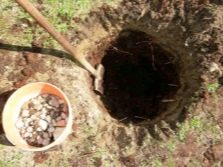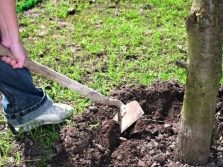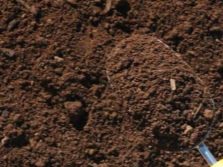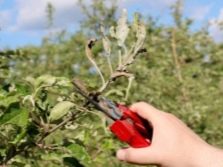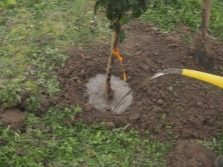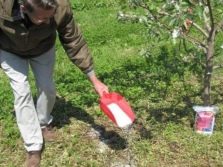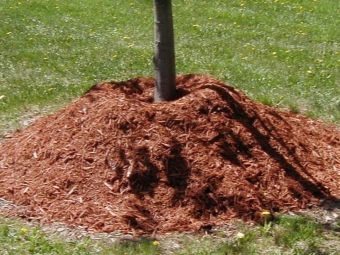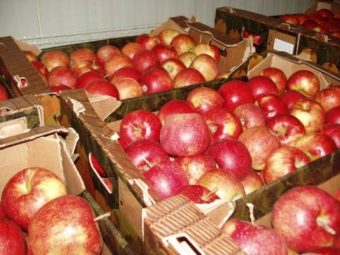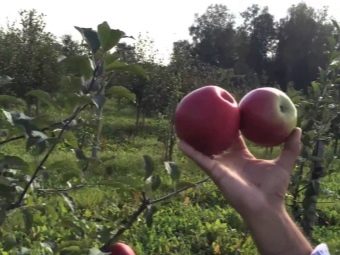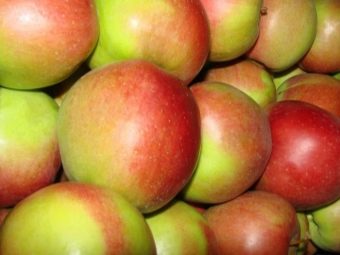Apple "Ligol": description of the variety, tips on growing
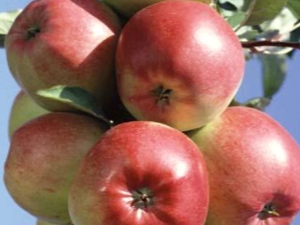
The apple tree of the Ligol variety was bred by Polish breeders in 1971. It is a winter-hardy plant that gives a good harvest of juicy and tasty apples.The most widespread culture in Russia, Ukraine and at home - in Poland.
Variety description
Frost-resistant apple tree "Ligol" is characterized by high yield. Technical ripeness fruits reach in the fall, the harvest is collected in late September and early October. Apples are distinguished by exceptional storage and can be stored until spring. The very first fruiting begins in the third year of the plant's life in the open field, while the fruit buds are formed before it is planted in a permanent place.
As a rule, for the first time 4-6 kg are harvested from a single tree, and in subsequent years the yield increases from year to year. "Ligol" is prone to periodic fruiting, so there are years when the apple tree is almost empty.
The tree is medium-sized, grows up to 3-3.5 m by 10 years. The crown has a pyramidal shape of medium thickening. The stem is thickened, the branches grow at an angle of 60-80 degrees relative to the trunk. The apple tree is distinguished by its increased shoot formation, as a result of which the yield is usually high.
Leaf plates are elongated, saturated dark green shade, the lower part is trimmed. Full fall foliage is completed by November. Flowering begins at a later date and lasts about 10 days. Inflorescences are white, rather large.
The cultivar belongs to the self-productive, therefore it requires pollinating trees. Gardeners recommend planting a row of apple trees such as Fuji, Golden Delicious, Vitos, Lobo, Spartan, Macintosh and others. At the same time, the Ligol apple tree itself can often act as a pollinator for most other varieties, with the exception of Idared and Jonagold.
The fruits are quite weighty, the mass of each varies from 150 to 450 g, on average, their weight is 300 g. Apples have a rounded shape, with pronounced seams on the sides. The skin is thick, smooth and slightly shiny. In most cases, it is colored in a yellow-green color with a carmine cover, and as it matures, the red color becomes predominant. Under the skin visible bright subcutaneous points in large quantities.
Taste properties are high - the fruits are sweet with almost elusive sourness, the smell is saturated, the flesh on the cut is fine-grained, juicy, creamy or white-yellow. Ligol tolerates transportation and storage, and is therefore often grown for commercial use.
Advantages and disadvantages
Apple tree varieties "Ligol" has both advantages and disadvantages. The benefits include:
- good frost resistance - the tree easily transfers frosts to-30 degrees;
- high yields - plants that have reached 8 years of age can produce up to 15.5 tons of high quality fruit per hectare;
- apples of this variety are distinguished by their versatility of use and can be used for raw consumption, as a component of fruit salad, for lobe and making juices, compotes, mashed potatoes, jams and pastes;
- fruits retain their presentation for six months;
- the culture is resistant to scab and powdery mildew;
- pleasant taste and delicate aroma.
There are very few minuses, among them - weak resistance to bacterial burn. In addition, under adverse external conditions, the plant is often affected by wood diseases. During long-term storage, apples are often affected by tanning of the skin and subcutaneous spotting, which gives the fruit an unpleasant bitter taste.
To prevent this, fruit should be stored in a cool place without access of sunlight.
Agrotechnology
If you have decided to grow the Ligol apple tree, the first thing you need to know is that in order to grow and grow the plant, areas open to sunlight and fertile, well-fertilized soil are required. Penumbra is allowed, but only if it is not too extensive and not constant.
The poor and depleted soils of Ligola are not suitable, as are the sites located in arid places: in this case, the flowering dates shift, and sometimes the apples do not have time to ripen. The proximity of groundwater is also fraught with a decrease in yield and deterioration of the taste characteristics of apples.
That is why the preparation of the site for planting should be given special attention. At this stage the following types of work should be carried out:
- weed removal;
- introduction of mineral and organic fertilizers;
- adding humus to the soil.
It is equally important to choose the right planting material. The seedling must have a sufficiently strong root system; there should be no damage on its bark. It is necessary that a young plant should have at least 4 branches, its height was about 1.5 meters, and 10 cm from the root collar should be grafted. Advice: if you want to buy a viable seedling, buy the material in specialized nurseries, and not on the market, because in this case you will have no guarantee that you are buying exactly the sort you want.
It is advisable to prepare the well for planting in advance, optimally for a month. To do this, dig a hole about 70x100 cm and cover it with a mixture of black soil with rotted manure, compost and peat. If the soil is too heavy, you can add sand. After the pit is filled, it should be poured abundantly and solutions of urea, superphosphate and potassium nitrate should be added.
A couple of hours before planting, you should put the roots of apple trees in a container with cool water, you can add drugs that stimulate rooting. Such manipulations will straighten the roots and prepare them for movement into the ground. Planting is done strictly vertically, the best - to fix the young plant to the support.
The apple tree is buried 4–10 cm before reaching the root collar, then it is covered with soil from the hole, rammed slightly and watered abundantly.
Caring for a plant does not require special skills and conditions. Periodically a plant is required loosening of the pristvolny circle and weeding. These activities should begin in the spring, for this they wait for the snow cover to descend, after which the area around the trunk is cleared of debris and dug up.
After each watering or heavy rain, the earth is usually covered with a cracked crust, which creates an obstacle in the path of oxygen to the root system. Therefore, after each irrigation, the land should be properly loosened. This should be done at least once a month.
After harvesting, at the stage of preparing the plant for wintering, the land is dug up and, if necessary, organic fertilizers (compost or rotted manure) are added to it. It is necessary to trim the shoots in time and form the crown. They do it twice per season: in the spring they carry out shaping pruning, and in summer they remove shoots that create excessive thickening. Before reaching adult size, the crown is shortened annually by 40-50 cm.
For the apple tree Ligol is very important regular wateringthat are carried out during flowering, at the stage of the formation of the fruit and a couple of weeks before harvest. In dry years, additional moistening can be carried out as needed. Watering should be abundant, however, turning the site into a standing marsh also does not follow - this inevitably leads to the death of the root system.
The plant responds well to top dressing, therefore, in early spring and late autumn the apple tree is fertilized with organic compounds, at the stage of active growth, mineral components are introduced with irrigation, especially the plant needs nitrogen, phosphorus and potassium. Keep in mind that the introduction of organic matter must be very careful, it is absolutely not allowed to fertilize with fresh manure or bird droppings - this leads to a burn of the roots.
Apple-tree varieties "Ligol" are resistant to scab and powdery mildew, however, the plant is susceptible to garden pests and other fungal diseases of the crop, which is why gardeners should carry out preventive treatments. After the snow melts, the boles and the crown are sprayed with insecticides, the same treatment can be repeated shortly before flowering begins.
In addition, in the spring, it is imperative to whiten the stem with lime, which creates an effective protection of the plant against ultraviolet rays and insect pests.
Despite the frost resistance of the plant, it should be prepared for sub-zero temperatures. For this, the ground in the near-stem circle in November is covered with mulch, most often peat or humus is used, but needles and sawdust can come up, the area is covered with agrofiber or ordinary roofing felt.
Harvested apples are stored in wooden boxes, laying them in layers, while between them you should put paper that will protect fruits from the spread of rot from one fruit to another. The storage itself must be carried out in a cellar, which is necessarily ventilated, otherwise the fruits will quickly lose their presentation and taste.
Gardeners reviews
Apple tree varieties "Ligol" received a lot of positive feedback from most gardeners. Summarizing them, we can draw the following conclusions about the value of this variety.
- The overwhelming majority of gardeners notes an increased yield of a variety, despite the fact that the very first harvest can be expected as soon as 3 years after planting the plant in open ground.
- Often, another positive fact appears in reviews - apples can be picked a little unripe, and they reach ripeness during storage. However, they can lie without losing their taste and nutritional value, until the next spring.
- A large number of reviews are devoted to the taste and aroma of apples, as well as the universality of the use of Ligol fruit. They are good for eating raw, and for making winter blanks.
- Despite the fact that Ligol is bred artificially and requires the obligatory presence of other pollinating plants, the yield of the variety has the highest rates.
- As a rule, this crop is grown with whole gardens, but the plant feels great in single plantings.
In general, the Ligol apple tree is a plant that is resistant to external adverse factors, and with traditional care for all horticultural crops it gives a good harvest of juicy and flavorful fruits.
About what characteristics of the apple varieties "Ligol", see the following video.

